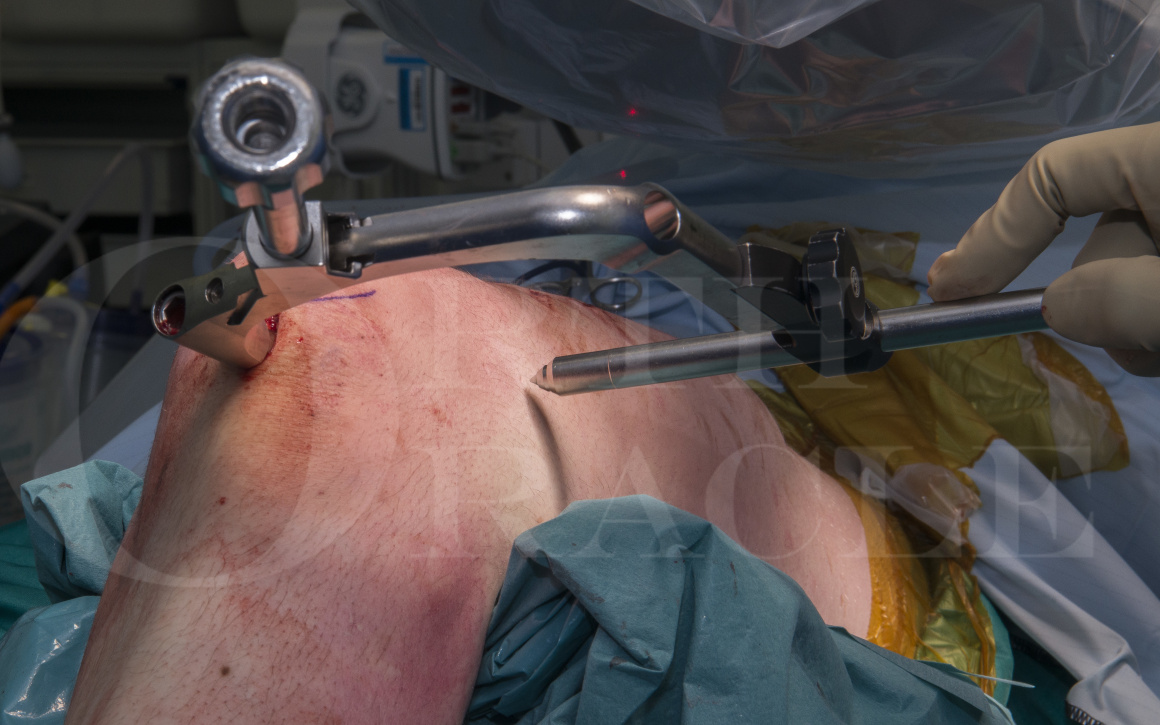Femoral shaft fracture: Fixation with Depuy-Synthes Expert retrograde/antegrade femoral nail (RAFN)
Overview

Subscribe to get full access to this operation and the extensive Hip Surgery Atlas.
Learn the Femoral shaft fracture: Fixation with Depuy-Synthes Expert retrograde/antegrade femoral nail (RAFN) surgical technique with step by step instructions on OrthOracle. Our e-learning platform contains high resolution images and a certified CME of the Femoral shaft fracture: Fixation with Depuy-Synthes Expert retrograde/antegrade femoral nail (RAFN) surgical procedure.
The retrograde/antegrade femoral nail (RAFN) is a versatile system whose benefits include:
- One system of instrumentation for retrograde and antegrade insertion.
- One system / implant for left and right femurs.
- An anatomic anterior bow that allows easier nail insertion.
- All nails are cannulated and can be inserted with either a reamed or unreamed technique.
- There is a large range of nail diameters available 9.0 mm to 15.0 mm
- There are multiple locking options including; static, dynamic, standard and blade options for osteoporotic bone.
It should be noted that a distal femoral nail is inserted with a retrograde technique and in some literature the words are often used to mean the same thing. However, this shouldn’t be confused with an antegrade nail (e.g. Lateral Femoral Nail – LFN) that is used to treat a distal third femoral fracture.
In a retrospective series by Kim et al., sixty patients undergoing femoral nailing for infra-isthmal fractures were reviewed. Thirty-eight patients were treated with an antegrade nail and twenty-two patients with a retrograde nail. They report no statistical difference in time to union, no difference in malalignment > 10 degrees and no difference in Knee Society scores. They did however find that the IM nail with the shorter working length distal to the fracture showed a strong relationship with nonunion.
In a systematic review and meta-analysis by Koso et al., they report that femoral shaft fractures developed nonunion in 6.6% of unreamed nails and 2.1% of reamed nails (p = 0.002). Therefore if the patient’s physiology will permit reaming of the femoral canal, this lowers the risk of developing a nonunion.
Kim JW et al. Treatment of infra-isthmal femoral fracture with an intramedullary nail: Is retrograde nailing a better option than antegrade nailing? Arch Orthop Trauma Surg 2018;138(9):1241-1247.
Koso RE et al. Healing, nonunion, and re-operation after internal fixation of diaphyseal and distal femoral fractures: a systematic review and meta-analysis. Int Orthop 2018;42(11):2675-2683.
Readers will may also find of use the following OrthOracle techniques:
Tibial intramedullary nailing (suprapatella approach): Synthes Expert Tibial Nail.
Author: Mr Ross Fawdington FRCS (Tr & Orth)
Institution: The Queen Elisabeth Hospital, Birmingham, UK.
Clinicians should seek clarification on whether any implant demonstrated is licensed for use in their own country.
In the USA contact: fda.gov
In the UK contact: gov.uk
In the EU contact: ema.europa.eu
Online learning is only available to subscribers.



















